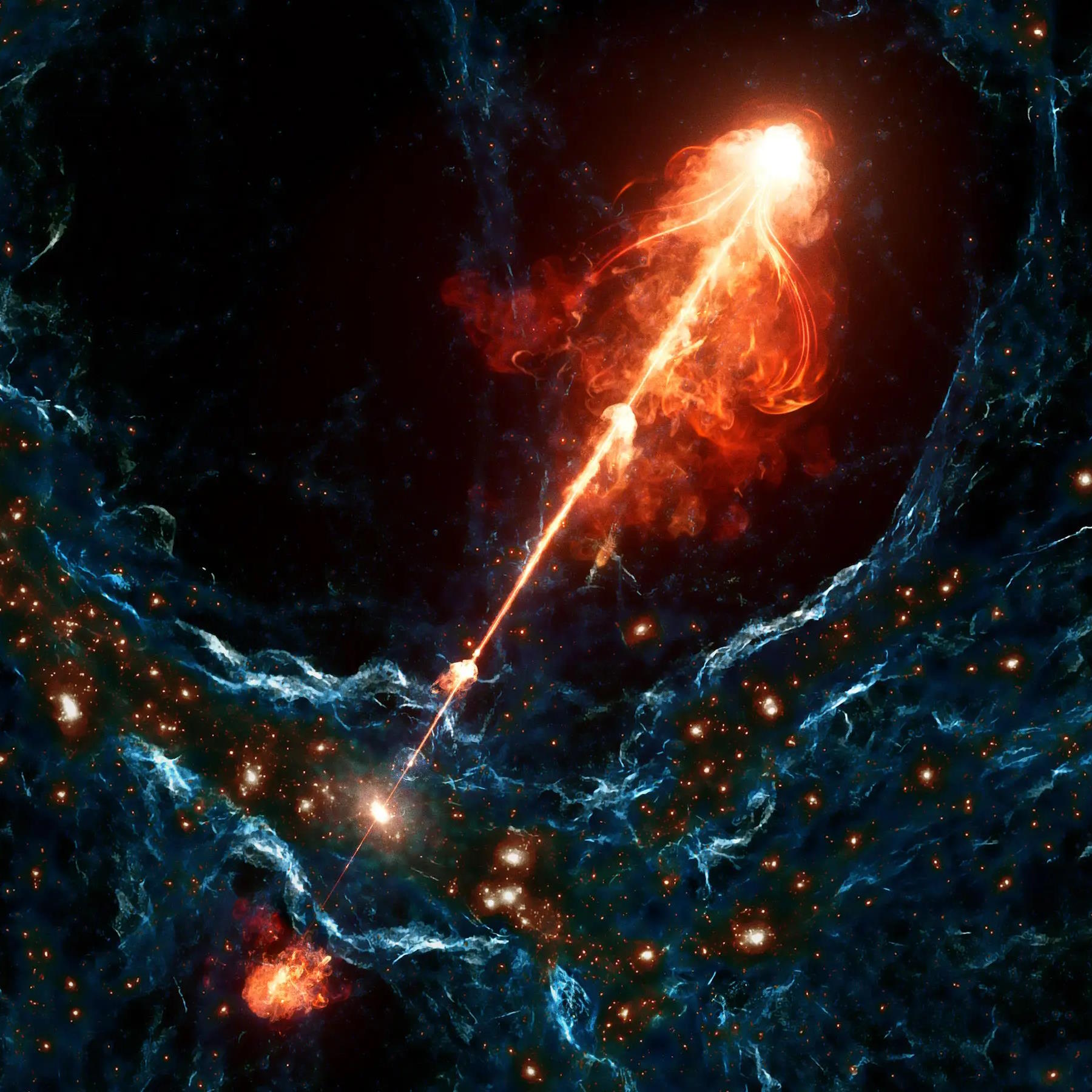Messier Monday: The Galaxy’s First Globular with a Black Hole, M62
Nearly 250 years since its discovery, this dense, brilliant core was found to have our Milky Way’s first globular-based black hole!
Image credit: Paulino Maldonado, via http://observatorioelojodeowi.blogspot.com/2011/05/subo-algunas-fotografias-de-espacio.html.
“And then you wake up, only to see that the darkness has gone, the light now truly makes you feel vulnerable and you wonder why this darkness did not wish you well and why did it leave you so sudden, without revealing the answers you were looking for.” –Chirag Tulsiani
With 110 deep-sky objects in the Messier catalogue, and each one holding it’s own story of how it came to be in this Universe, it’s no surprise that some of them will be quite unusual. But the summer months provide a rare chance for northern hemisphere skywatchers to catch some objects well below the celestial equator, including today’s object, Messier 62.
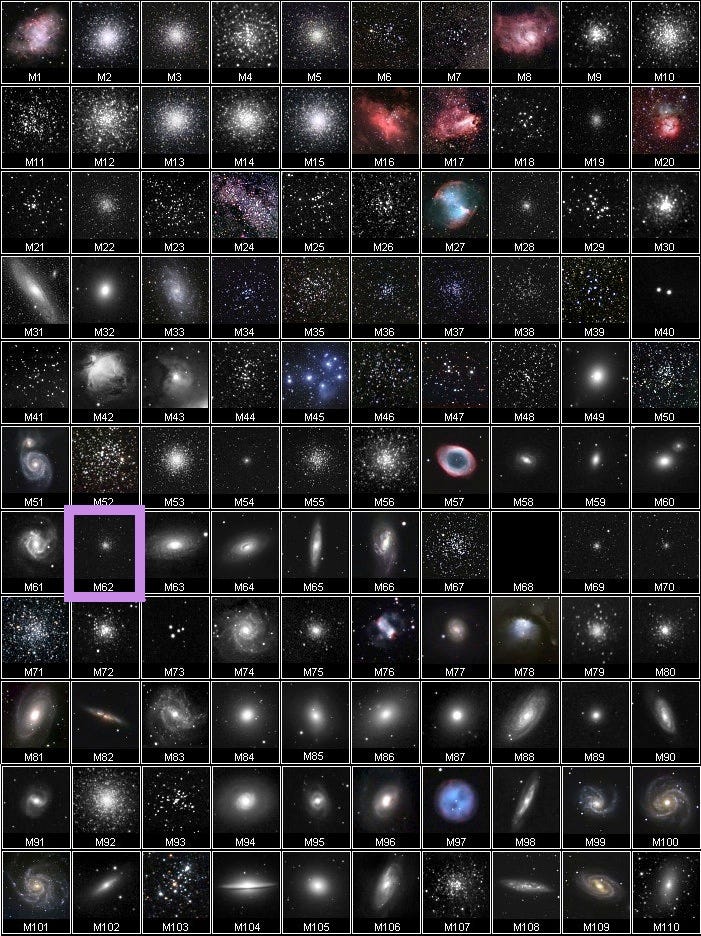
There are a great many globular clusters in the Messier catalogue: 29 of them, outnumbered only by the galaxies. In addition, there are over 100 others that are located in our galaxy’s halo, and they’ve all been around for far longer than our star and planet. In fact, the stars found in globular clusters are among the oldest in the Universe, and are often home to some of the most remarkable, evolved objects known to exist in space.
Messier 62, although it’s just one particular instance of a globular cluster, has a story all its own to tell. Here’s how to find it.
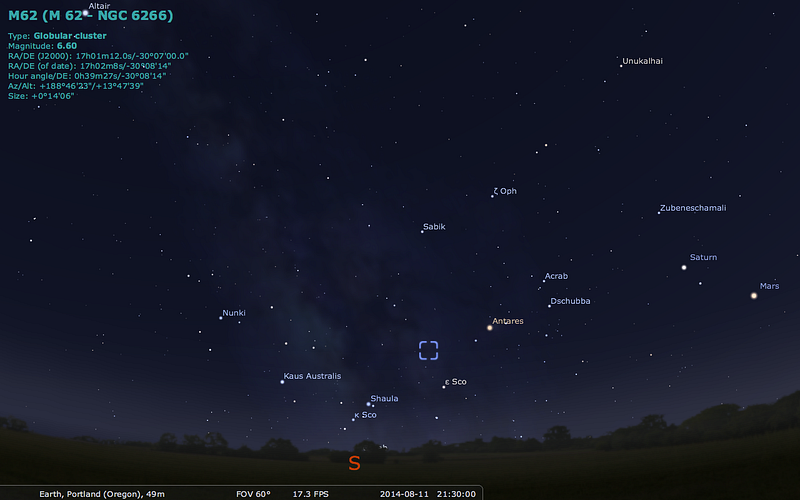
Shortly after sunset, just after the sky darkens, have a look due south. If you’re at a relatively high northern latitude (like I am), you’ll have to look fairly close to the horizon to find it, but the bright orange giant Antares just slightly to the west should help you out, along with the collection of stars that looks like a teapot towards the east.
Just southeast of Antares is another prominent (but not quite as bright) star, ε Scorpii, which will help guide you in the right direction.
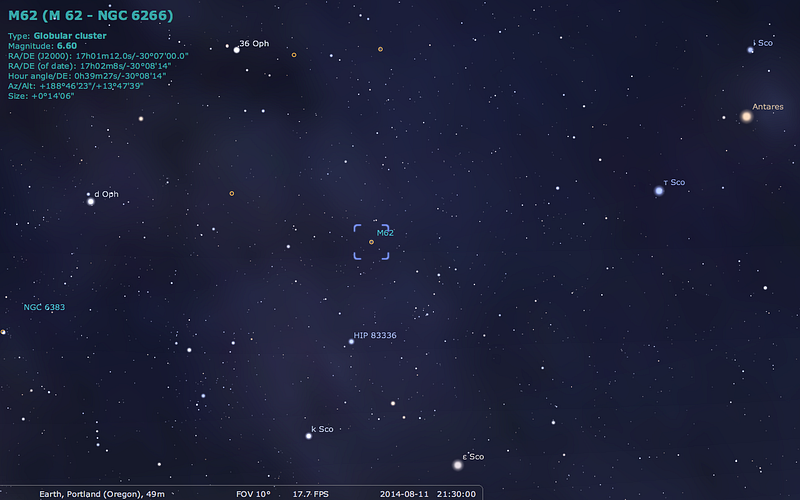
If you imagine that the line segment connecting Antares to ε Scorpii is the hypotenuse of a 30–60–90 right triangle, and that the right-angle-vertex is just north and slightly towards the east of ε Scorpii, that’ll put you almost exactly where Messier 62 is located!
Alternately, the naked eye star HIP 83336 is northeast of ε Scorpii, and navigating just about 2.5° north (and slightly west) of that star will plant you right at this globular, where the surrounding star field is as shown below.
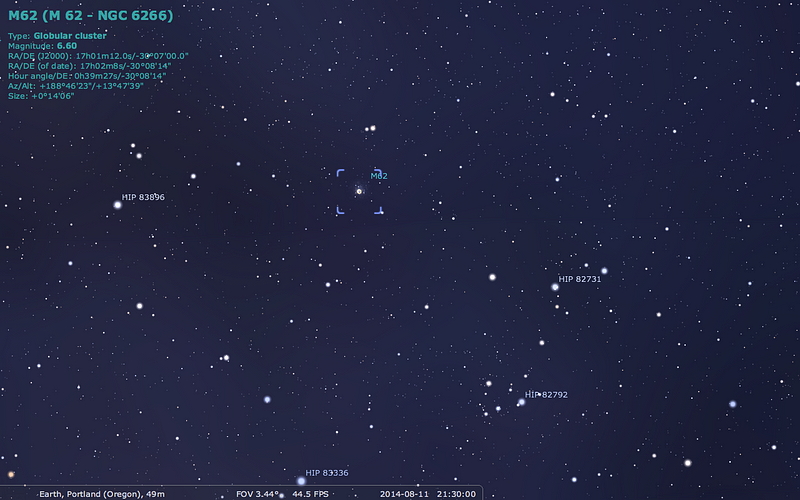
This was discovered by Messier himself back in 1771, but he didn’t accurately catalogue its position until 8 years later, writing:
Very beautiful nebula, discovered in Scorpio, it resembles a little Comet, the center is brilliant & surrounded by a faint glow.
That description — of a brilliant center with a faint glow around it — is what most globular clusters look like through a small telescope.
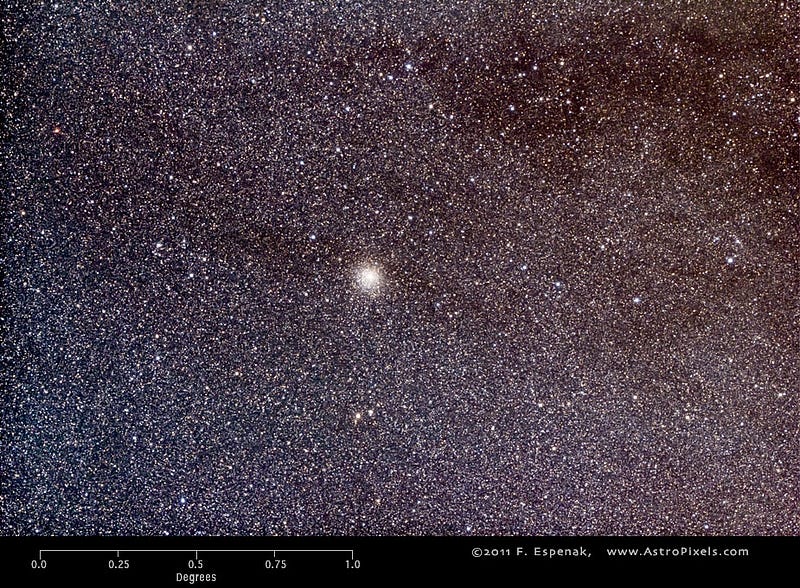
When star clusters form, they typically are somewhat denser towards the center, but not necessarily significantly so. For the most massive ones — and this one weighs in at about 1.2 million solar masses — the more massive stars tend to migrate towards the center. There, they merge and form blue stragglers, they run out of fuel (because more massive stars run out of fuel more quickly) and become white dwarfs, neutron stars or even black holes!
When we look at this globular, we see that it is, in fact, much denser towards the core than on the outskirts, something visible even against the backdrop of our galactic plane.
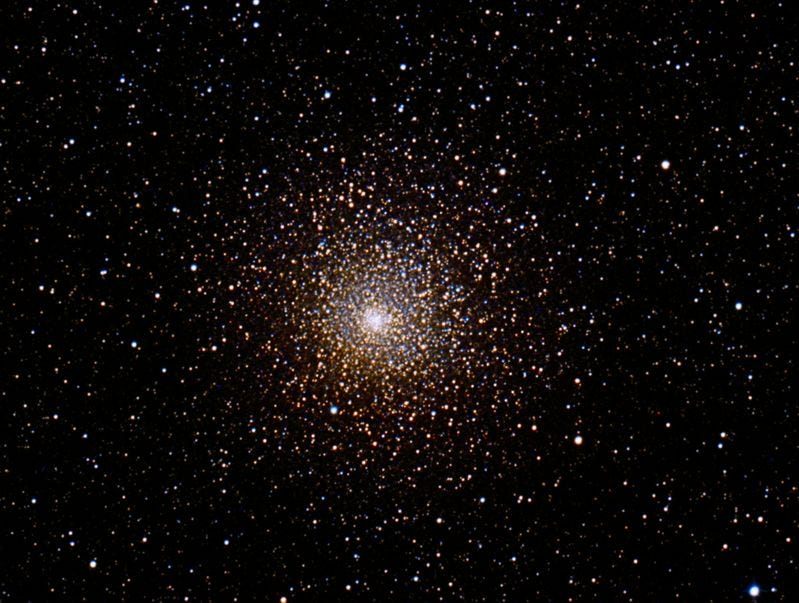
There are a huge number of variable stars in this cluster — 89 at last count, compared with a mere four for its globular neighbor, M19 — as well as a large number of X-ray sources, which are thought to be a mix of binary stars and millisecond pulsars. These clearly come in two different varieties, as the X-ray image of this cluster, courtesy of Chandra, shows us.
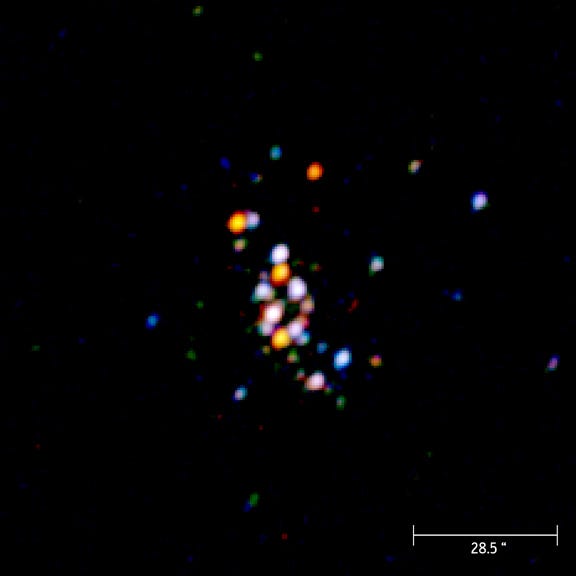
But it’s the incredibly dense central core that should interest you the most.
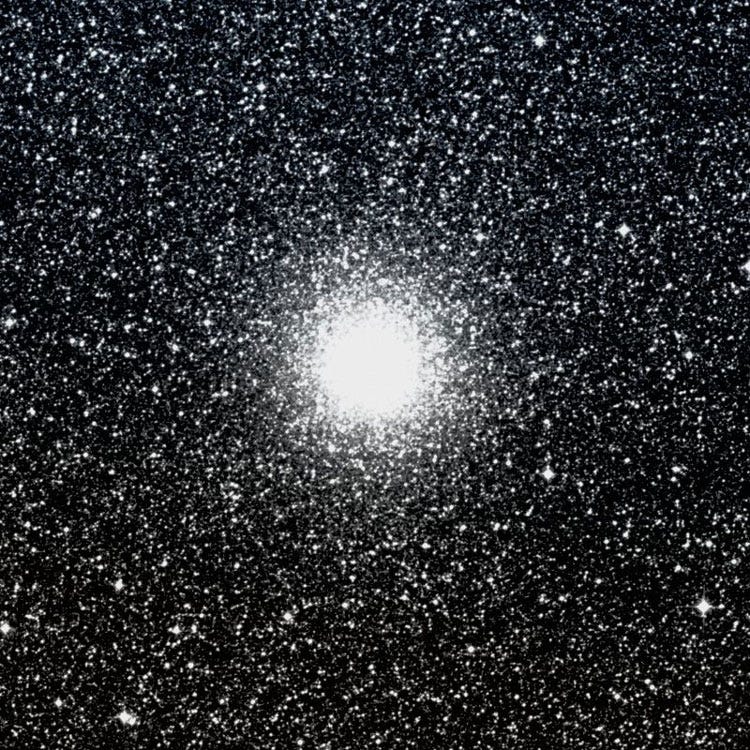
Because this is where the most massive, densest, and in many ways most interesting objects can be found. In a cluster that’s maybe 10 times as massive as the smaller globulars, there are bound to be some remnants of long-dead, massive stars to look at.
One of the classes of object that should be left behind from the earliest generations of stars to form in here is a stellar-mass black hole, but for centuries, not a single one was found in a globular cluster anywhere.
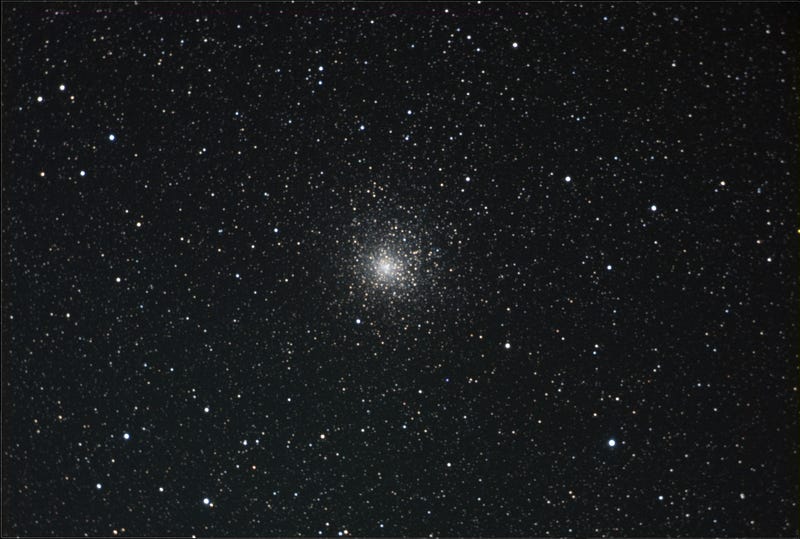
Traditionally, black holes are detected by using radio waves, but globular clusters are simply too dense and too noisy to have that be a reliable method. Instead, it’s X-rays from gas being accelerated and heated up by the black hole that’s the first signature, which can then be followed-up with high-resolution radio observations to provide confirmation.
The first globular cluster to house a black hole was only discovered in 2007, but that was outside our galaxy. Using that same technique, however, proved incredibly fruitful for Messier 62!
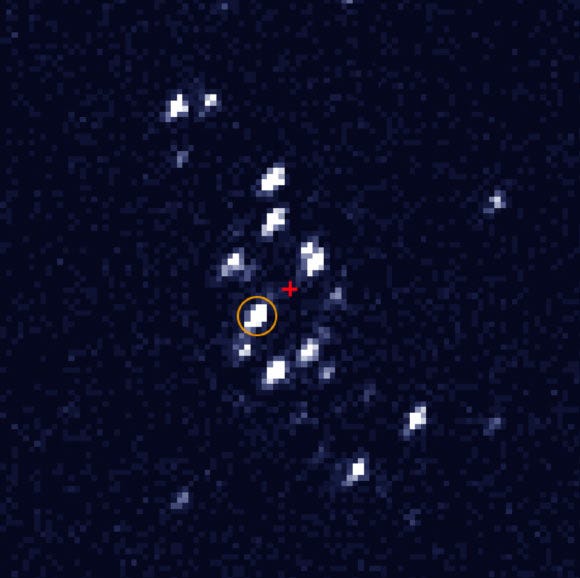
The circle, above, marks the spot where X-rays were observed (by Chandra), indicating the presence of a black hole. This was confirmed with radio observations courtesy of the Very Large Array!
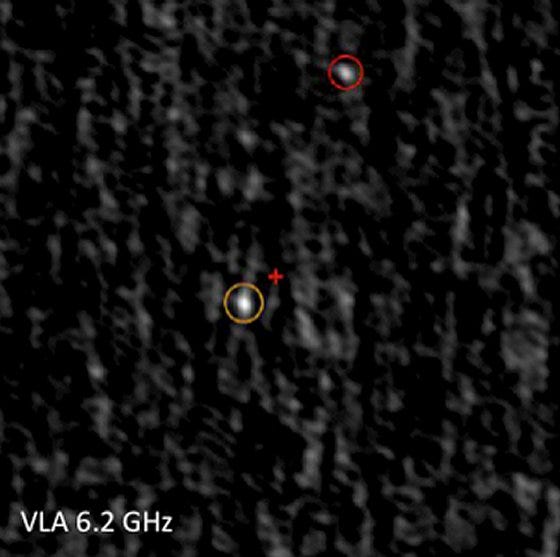
In fact, it’s real and it’s confirmed! We now have the very first stellar-mass black hole discovered in a globular cluster in our Milky Way, and — along with the more massive ones that have been found in others — this is a strong hint that there are likely many more to come!
The best image of this cluster’s core comes, as it so often does, courtesy of the Hubble Space Telescope, which had the occasion to image the central portion of this remarkable object.
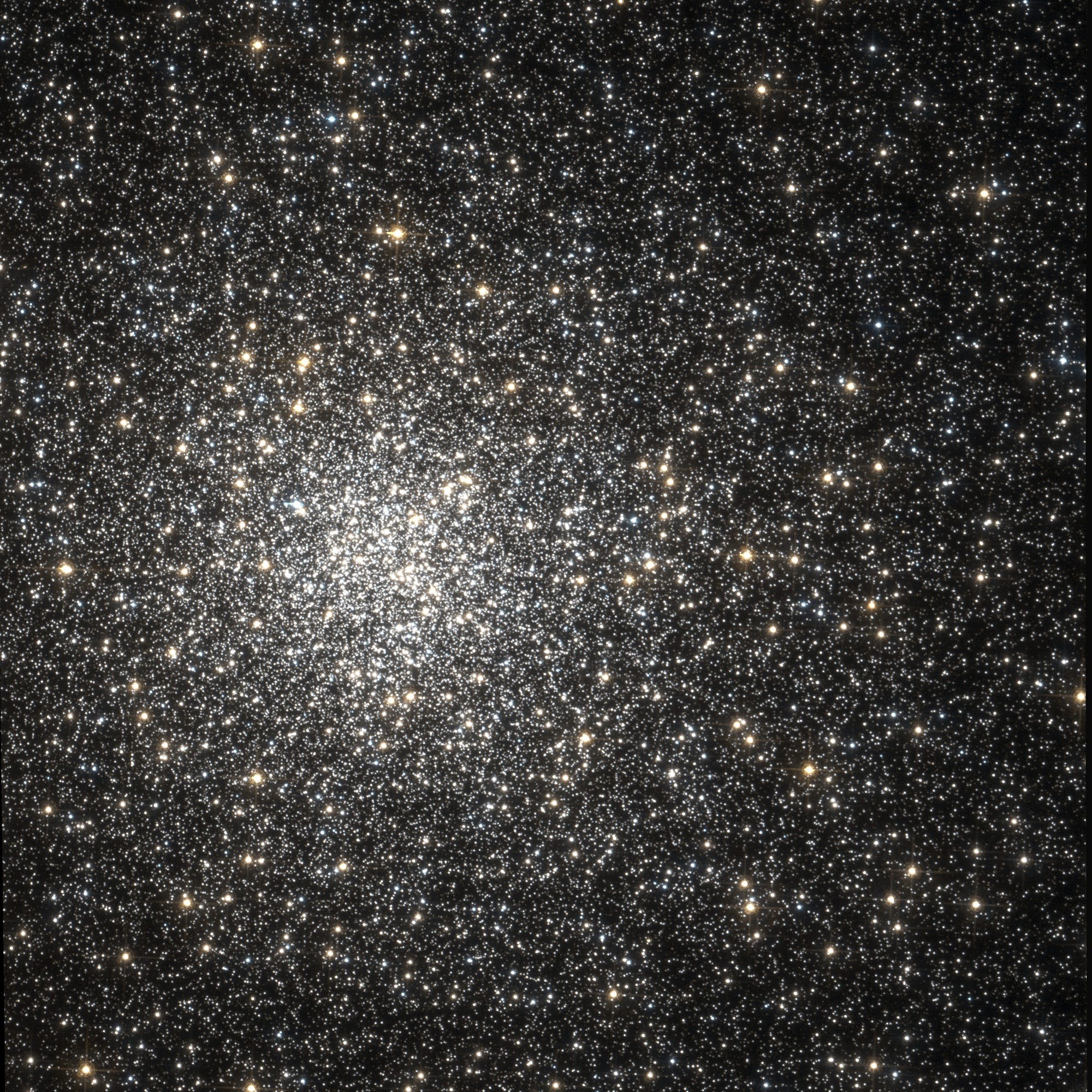
And with that, we’ll come to the remarkable end of another Messier Monday. Out of the 110 objects, we’ve now taken a detailed look at 95 of them, leaving just 15 to go. Take a look back at all our previous objects:
- M1, The Crab Nebula: October 22, 2012
- M2, Messier’s First Globular Cluster: June 17, 2013
- M3, Messier’s First Original Discovery: February 17, 2014
- M4, A Cinco de Mayo Special: May 5, 2014
- M5, A Hyper-Smooth Globular Cluster: May 20, 2013
- M7, The Most Southerly Messier Object: July 8, 2013
- M8, The Lagoon Nebula: November 5, 2012
- M9, A Globular from the Galactic Center: July 7, 2014
- M10, A Perfect Ten on the Celestial Equator: May 12, 2014
- M11, The Wild Duck Cluster: September 9, 2013
- M12, The Top-Heavy Gumball Globular: August 26, 2013
- M13, The Great Globular Cluster in Hercules: December 31, 2012
- M14, The Overlooked Globular: June 9, 2014
- M15, An Ancient Globular Cluster: November 12, 2012
- M18, A Well-Hidden, Young Star Cluster: August 5, 2013
- M20, The Youngest Star-Forming Region, The Trifid Nebula: May 6, 2013
- M21, A Baby Open Cluster in the Galactic Plane: June 24, 2013
- M23, A Cluster That Stands Out From The Galaxy: July 14, 2014
- M24, The Most Curious Object of All: August 4, 2014
- M25, A Dusty Open Cluster for Everyone: April 8, 2013
- M27, The Dumbbell Nebula: June 23, 2014
- M29, A Young Open Cluster in the Summer Triangle: June 3, 2013
- M30, A Straggling Globular Cluster: November 26, 2012
- M31, Andromeda, the Object that Opened Up the Universe: September 2, 2013
- M32, The Smallest Messier Galaxy: November 4, 2013
- M33, The Triangulum Galaxy: February 25, 2013
- M34, A Bright, Close Delight of the Winter Skies: October 14, 2013
- M36, A High-Flying Cluster in the Winter Skies: November 18, 2013
- M37, A Rich Open Star Cluster: December 3, 2012
- M38, A Real-Life Pi-in-the-Sky Cluster: April 29, 2013
- M39, The Closest Messier Original: November 11, 2013
- M40, Messier’s Greatest Mistake: April 1, 2013
- M41, The Dog Star’s Secret Neighbor: January 7, 2013
- M42, The Great Orion Nebula: February 3, 2014
- M44, The Beehive Cluster / Praesepe: December 24, 2012
- M45, The Pleiades: October 29, 2012
- M46, The ‘Little Sister’ Cluster: December 23, 2013
- M47, A Big, Blue, Bright Baby Cluster: December 16, 2013
- M48, A Lost-and-Found Star Cluster: February 11, 2013
- M49, Virgo’s Brightest Galaxy: March 3, 2014
- M50, Brilliant Stars for a Winter’s Night: December 2, 2013
- M51, The Whirlpool Galaxy: April 15th, 2013
- M52, A Star Cluster on the Bubble: March 4, 2013
- M53, The Most Northern Galactic Globular: February 18, 2013
- M56, The Methuselah of Messier Objects: August 12, 2013
- M57, The Ring Nebula: July 1, 2013
- M58, The Farthest Messier Object (for now): April 7, 2014
- M59, An Elliptical Rotating Wrongly: April 28, 2014
- M60, The Gateway Galaxy to Virgo: February 4, 2013
- M61, A Star-Forming Spiral: April 14, 2014
- M62, The Galaxy’s First Globular With A Black Hole: August 11, 2014
- M63, The Sunflower Galaxy: January 6, 2014
- M64, The Black Eye Galaxy: February 24, 2014
- M65, The First Messier Supernova of 2013: March 25, 2013
- M66, The King of the Leo Triplet: January 27, 2014
- M67, Messier’s Oldest Open Cluster: January 14, 2013
- M68, The Wrong-Way Globular Cluster: March 17, 2014
- M71, A Very Unusual Globular Cluster: July 15, 2013
- M72, A Diffuse, Distant Globular at the End-of-the-Marathon: March 18, 2013
- M73, A Four-Star Controversy Resolved: October 21, 2013
- M74, The Phantom Galaxy at the Beginning-of-the-Marathon: March 11, 2013
- M75, The Most Concentrated Messier Globular: September 23, 2013
- M77, A Secretly Active Spiral Galaxy: October 7, 2013
- M78, A Reflection Nebula: December 10, 2012
- M79, A Cluster Beyond Our Galaxy: November 25, 2013
- M80, A Southern Sky Surprise: June 30, 2014
- M81, Bode’s Galaxy: November 19, 2012
- M82, The Cigar Galaxy: May 13, 2013
- M83, The Southern Pinwheel Galaxy, January 21, 2013
- M84, The Galaxy at the Head-of-the-Chain, May 26, 2014
- M85, The Most Northern Member of the Virgo Cluster, February 10, 2014
- M86, The Most Blueshifted Messier Object, June 10, 2013
- M87, The Biggest One of them All, March 31, 2014
- M88, A Perfectly Calm Spiral in a Gravitational Storm, March 24, 2014
- M89, The Most Perfect Elliptical, July 21, 2014
- M90, The Better-You-Look, The Better-It-Gets Galaxy, May 19, 2014
- M91, A Spectacular Solstice Spiral, June 16, 2014
- M92, The Second Greatest Globular in Hercules, April 22, 2013
- M93, Messier’s Last Original Open Cluster, January 13, 2014
- M94, A double-ringed mystery galaxy, August 19, 2013
- M95, A Barred Spiral Eye Gazing At Us, January 20, 2014
- M96, A Galactic Highlight to Ring in the New Year, December 30, 2013
- M97, The Owl Nebula, January 28, 2013
- M98, A Spiral Sliver Headed Our Way, March 10, 2014
- M99, The Great Pinwheel of Virgo, July 29, 2013
- M100, Virgo’s Final Galaxy, July 28, 2014
- M101, The Pinwheel Galaxy, October 28, 2013
- M102, A Great Galactic Controversy: December 17, 2012
- M103, The Last ‘Original’ Object: September 16, 2013
- M104, The Sombrero Galaxy: May 27, 2013
- M105, A Most Unusual Elliptical: April 21, 2014
- M106, A Spiral with an Active Black Hole: December 9, 2013
- M107, The Globular that Almost Didn’t Make it: June 2, 2014
- M108, A Galactic Sliver in the Big Dipper: July 22, 2013
- M109, The Farthest Messier Spiral: September 30, 2013
And come back tomorrow for more wonders of the Universe, and don’t forget to look up and catch the Perseids all this week if you have the skies for it!
Leave your comments at the Starts With A Bang forum on Scienceblogs!


